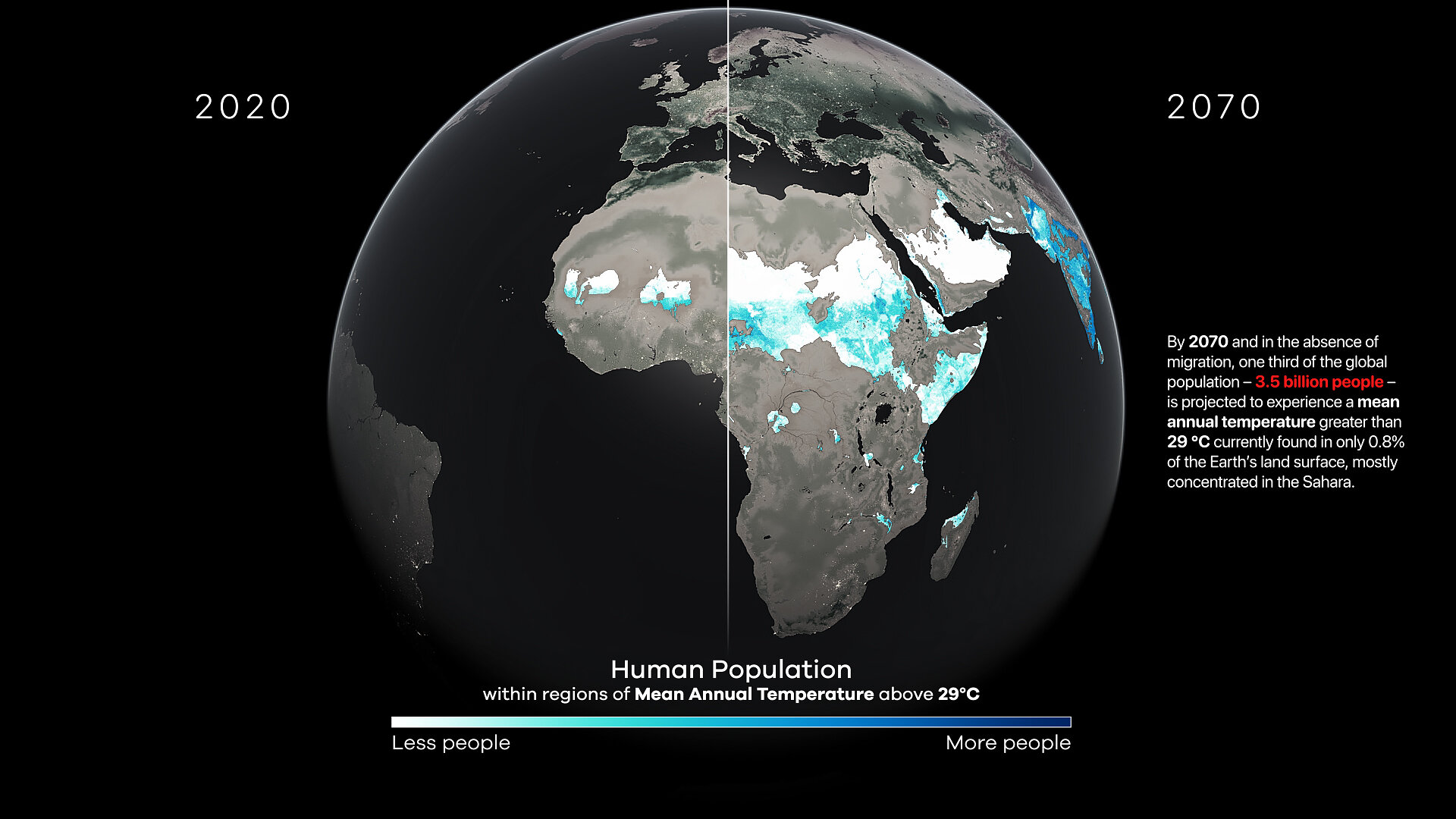🌍🌡️
A Tale of Humanity and Habitability
Throughout history, humans have predominantly inhabited a surprisingly limited range of Earth's diverse climates, typically characterised by a mean annual temperature of around 13°C, i.e. human climate niches. This distribution may be a result of the human temperature niche, which is influenced by fundamental constraints. These findings show that, depending on future population growth and climate warming scenarios, between 1 and 3 billion people could find themselves living outside the climate conditions that have supported human flourishing for the past 6,000 years over the next half-century.
If climate change mitigation efforts are not implemented or large-scale migration does not occur, a significant portion of humanity may face exposure to mean annual temperatures that are warmer than those experienced in almost any location today. This underscores the urgent need for proactive measures to address the challenges posed by climate change and ensure the continued well-being of populations across the globe.
Special thanks to Tim, Xu, Marten and Owen.
🔺 Quantifying the human cost of global warming
Timothy M. Lenton, Chi Xu, Jesse F. Abrams, Ashish Ghadiali, Sina Loriani, Boris Sakschewski, Caroline Zimm, Kristie L. Ebi, Robert R. Dunn, Jens-Christian Svenning & Marten Scheffer.
Nature Sustainability, 2023.
https://doi.org/10.1038/s41893-023-01132-6
🔺 Future of the human climate niche
Chi Xu, Timothy A. Kohler, Timothy M. Lenton, Jens-Christian Svenning, Marten Scheffer
Proceedings of the National Academy of Sciences, 2020.
https://doi.org/10.1073/pnas.191011411
NARRATION
‘A Tale of Humanity and Habitability’
This is Earth. Our Home World. A Blue Marvel.
Our common heritage, and every child’s birthright, is a stable and resilient planet.
This is changing, at our expense.
Global warming is disrupting ecosystems. It is disrupting human health and livelihoods, food security and our water supply. It is disrupting economic growth.
A new study has revealed Humanity's Goldilocks Zone on Earth. Not too hot nor too cold, our climate niche, the niche where we have thrived for ten thousand years, is a temperature between 11 and 15 °C.
But billions of people will soon be living far beyond this niche.
Following current trends for climate and population growth, the temperature an average human will experience is projected to change more in the coming decades than it has over the past six millennia.
Compared with the preindustrial era 300 years ago, the mean temperature rise that people will experience by 2070 will amount to an estimated 7.5 °C. This is more than twice the average global temperature rise, a discrepancy largely due to the fact the land will warm much faster than the oceans, and because population growth is biased to already hot places.
By 2070 one third of the global population is projected to experience an average annual temperature greater than a scorching 29 °C.
For 3.5 billion of us, the very places where our hearts and identities lie may become parched and unforgiving deserts, or hot and humid open-air sauna.
Our house is on fire.
By rapidly reducing greenhouse gas emissions, we can halve the number of people exposed to such hot conditions.
For every degree of warming we prevent, we can relieve one billion people.
Our common heritage, and every child’s birthright, is a stable, resilient and inhabitable planet.
Take action to stabilise our planet. Now.
Human Cost of Global Warming · 2023
Climate change is already affecting us. Right now, about 9% of the world's population, which is over 600 million people, are living in areas that are outside the 'human climate niche'. This term refers to the range of temperatures where humans have traditionally lived.
If we continue on our current path, which is leading to a global warming of around 2.7 °C, by the end of this century (2080-2100), one-third (22-39%) of the world's population could be living outside this 'human climate niche'. This means that billions of people could be living in areas that are too hot for humans to comfortably or safely live.
However, if we can reduce global warming from 2.7 °C to 1.5 °C, we could decrease by five times the number of people exposed to unprecedented heat (mean annual temperature ≥29 °C).
The study also finds that the lifetime emissions of about 3.5 average global citizens today (or 1.2 average US citizens) will expose one future person to unprecedented heat by the end of the century. Interestingly, that future person is likely to come from a place where emissions today are around half of the global average.
These findings highlight the urgent need for more decisive policy action to limit the human costs and inequities of climate change. It also underscores the need for a shift in how we view borders and immigration, as more people may need to move due to these environmental changes.
Human Climate Niches in green 🟩 and regions of Mean Annual Temperature >29 °C (MAT >29 °C) in purple 🟪.
The MAT >29°C is an important threshold as beyond this point, humans are exposed to historically unprecedented levels of heat, with an increased frequency of potentially lethal maximum temperatures over 40°C and physiologically challenging wet bulb temperatures (WBT) over 28°C, posing serious threats to health and survival.
Accessible Map.
Human Climate Niches in green 🟩 and regions of Mean Annual Temperature >29 °C (MAT >29 °C) in red 🟥.
Alternative Colors.
Human Climate Niches in green 🟩 and regions of Mean Annual Temperature >29 °C (MAT >29 °C) in red 🟥.
Projected populations exposed to unprecedented heat as global average temperature rises.
This animation shows parts of the world where the mean annual temperature will be above 29C – dangerously hot for humans – at 1.5C of global warming, then at 2.7C warming. Finally, it combines 2.7C warming with “human presence” – revealing the densely populated areas that could be affected. Credit: Lenton, Chi, et al. and Globaïa















